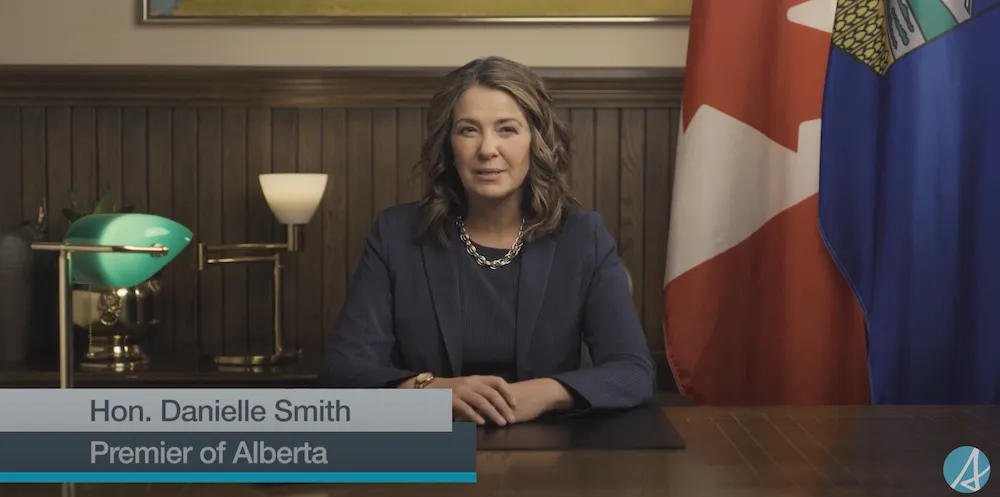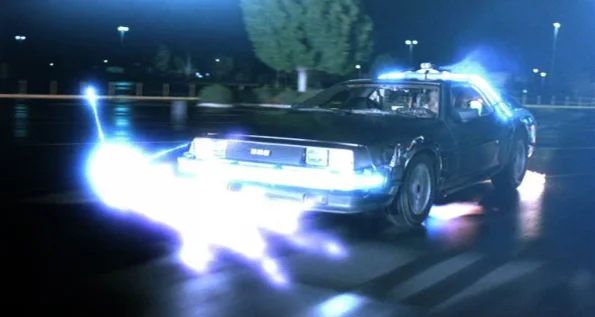It was 1975 and Lougheed’s PCs were swimming in oil money like Scrooge McDuck
The Heritage Savings Trust Fund was front and centre in Premier Danielle Smith‘s pre-budget televised speech last week, so there’s a good chance Albertans are going to hear a lot about it when Finance Minister Nate Horner rises in the Legislative Assembly this afternoon to table the provincial government’s annual budget.
In her 8-minute address to Albertans, Smith said she wants to funnel oil and gas royalty revenues into the Heritage Savings Trust Fund to increase it to between $250 and $400 billion by 2050. A report to the Standing Committee on the Alberta Heritage Savings Trust Fund reported the fund had a market value of $21.6 billion in 2023.
Many Albertans know the patriotic version of the Heritage Savings Trust Fund story – a visionary rainy day bank account created in the 1970s by former premier Peter Lougheed meant to preserve Alberta’s oil wealth for future generations. But like many political stories that reach legendary status it is missing a lot of relevant historical context.
Read the rest on the Daveberta Substack.
Sign up for a paid subscription to get access to the Daveberta Podcast and special Alberta politics extras.
- Tags 2024 Alberta NDP Leadership Race, Adriana LaGrange, Alberta Budget 2024, Alberta Heritage Savings Trust Fund, Alberta NDP, Anaida Poilievre, Brian Jean, Corb Lund, Danielle Smith, Daveberta Substack, David Climenhaga, David Parker, Don Braid, Gil McGowan, Gordon Miniely, Grant Notley, Harry Strom, Janet Brown, Jenni Byrne, Jodi Calahoo Stonehouse, Max Fawcett, Nate Horner, Perry Bellegarde, Peter Lougheed, Pierre Poilievre, Sarah Hoffman, Scooge McDuck, Take Back Alberta, Tyler Gandam, United Conservative Party, Werner Schmidt

The political history of Alberta is filled with larger than life characters. I read a lot about Alberta history, and while politicians like William Aberhart, Ernest Manning, Peter Lougheed, and Ralph Klein dominate the history books, I have frequently come across some really interesting lesser known characters. I thought it would be interesting to share are a few of those names with you today.
Read the rest on the Daveberta Substack.
Sign up for a paid subscription to get access to the Daveberta Podcast and special Alberta politics extras
- Tags Alberta History, Alberta Liberal Party, Bettie Hewes, Camrose, Chester Ronning, Daveberta Substack, Edith Rogers, Edmonton-Gold Bar, Ernest Manning, John Brownlee, John Kushner, John Leedy, Joseph Unwin, Nick Taylor, Peter Lougheed, Ponoka, Ralph Klein, United Farmers of Alberta, Walter Makowecki, William Aberhart

United Conservative Party leader Danielle Smith and Alberta NDP leader Rachel Notley will face each other at 7:00 pm tonight in the only televised leaders debate of Alberta’s election campaign.
This is the first time Alberta has had a TV debate featuring only two party leaders, but both people taking the stage have experience doing this before.
This is Notley’s third televised debate since 2015 and it’s Smith’s second.
Read the rest on the Daveberta Substack. Sign up for a paid subscription to get access to the Daveberta Podcast and special election extras.
- Tags Alberta Election 2023, Alberta Election Leaders' Debate, Alberta NDP, Brian Mason, Danielle Smith, Daveberta Substack, Don Getty, Edmonton-Whitemud, Ernest Manning, Grant Notley, Jason Kenney, Jennifer Johnson, Jim Prentice, Kevin Taft, Lacombe-Ponoka, Laurence Decore, Michael Maccagno, Nancy MacBeth, Neil Reimer, Paul Hinman, Peter Lougheed, Rachel Notley, Raj Pannu, Raj Sherman, Ralph Klein, Randy Thorsteinson, Take Back Alberta, United Conservative Party

The calm before the storm. The deep breath before the plunge.
Tomorrow is the day.
Tomorrow is by-election day in Fort McMurray-Lac La Biche.
They’ve been overshadowed by Jason Kenney’s leadership review, the occupation of Ottawa, a blockade at Coutts, and the Russian invasion of Ukraine, but tomorrow the people of northern Alberta’s famed boom town get their say.
They get to choose an MLA.
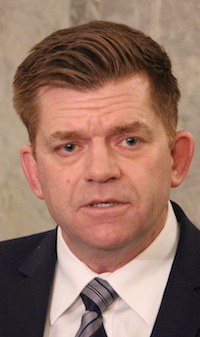
Brian Jean is the favourite to win.
He’s the former MLA, former MP, and former leader of the Wildrose Party.
He’s Fort Mac’s golden boy.
Now he’s the United Conservative Party candidate.
He’s also Jason Kenney’s worst enemy and if he wins he’ll become an even bigger thorn in the Premier’s side ahead of the April 9 leadership review.
Kenney beat Jean in the 2017 UCP leadership race and is now openly campaigning against him in the leadership review.
Jean isn’t the only anti-Kenney candidate in the race.

NDP candidate Ariana Mancini is campaigning hard.
The NDP are cautiously optimistic about their chances but it’s a real long shot and know they are the underdog.
Even with the NDP leading the UCP by 15 points in province-wide polls and Kenney’s approval ratings in free fall, there is still a big gap to close in Fort McMurray-Lac La Biche.
The UCP won the riding with 66 per cent of the vote in 2019.
Competing with Jean for disaffected conservative voters is another former Wildrose Party leader, Paul Hinman.
Hinman now leads the separatist Wildrose Independence Party.
He’s another long-shot candidate.
He’s also living proof that by-elections can produce weird and unpredictable results.
What do I mean?
Hop in and join me in the Alberta Politics Time Machine™.
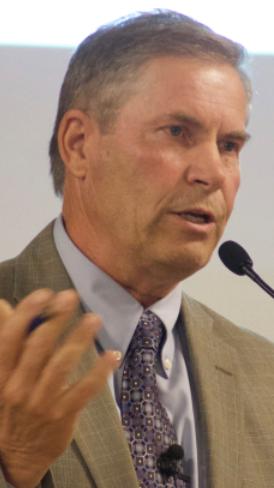
One year after Hinman was lost his Cardston-Taber-Warner seat in the 2008 general election he shocked political watchers by winning a by-election in posh Calgary-Glenmore in the city’s southwest.
It was a real country-mouse-becomes-city-mouse situation.
But Hinman isn’t the only example of how by-elections can be sometimes have shocking results.
The Liberals stunned political watchers when Craig Cheffins won in the Calgary-Elbow by-election to replace retired Premier Ralph Klein in 2007.
Alberta Party leader Greg Clark very nearly repeated history in 2014 when he placed a painfully close second to PC cabinet minister Gord Dirks in another Calgary-Elbow by-election.
“But Dave,” you say, “aren’t those just fancy urban Calgary ridings?”
Hold on.
There’s more.
The Liberals won the 1992 by-election in Three Hills.
Yes. That’s right. Three. Hills.
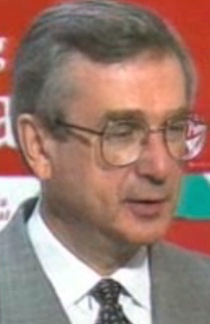
Deficit hawk Liberal leader Laurence Decore recruited farm realtor Don MacDonald in that by-election.
It was a sign of how well the Liberals were doing as much as how poorly the old Progressive Conservatives had tumbled under Don Getty’s beleaguered premiership.
“This is the heartland of Conservative Alberta,” Decore told a boisterous crowd of supporters in Three Hills on the night of MacDonald’s win.
He won with a stunning 2,476 lead over the second place Social Credit candidate.
The PC placed third.
“This is rural Alberta. This is where it’s not supposed to happen. This is where Liberals are supposed to be the anathema of everything that this area stands for,” Decore said. “Not only are we winning but we’re winning handsomely.”
The Liberals even came within a hair of winning a by-election in Little Bow a few months earlier.
Yes. Little. Bow.
That’s the deep south and it’s where conservatives usually win big.
The Reform Party of Canada was on the rise and, just like Three Hills a few months later, Reformers were split between the provincial Liberals and Tories in that by-election.
Reformer-turned-Liberal Donna Graham finished 262 votes behind Reformer-turned-Tory winner Barry MacFarland.
It was a close race.

And then there’s the big by-election win that people always talk about when Alberta separatism periodically peaks in the polls: Western Canada Concept’s Gordon Kesler winning the 1982 Olds-Didsbury by-election.
It was the only time a separatist party candidate has been elected to the Alberta Legislature.
People were mad.
Mad at Pierre Trudeau.
Mad at Peter Lougheed.
And boy did they show it.
But Kesler only had a few months as an MLA before Lougheed shifted gears and steamrolled the WCC into electoral oblivion in the November 1982 general election.
Ok. Buckle up.
Let’s take the time machine back even further.
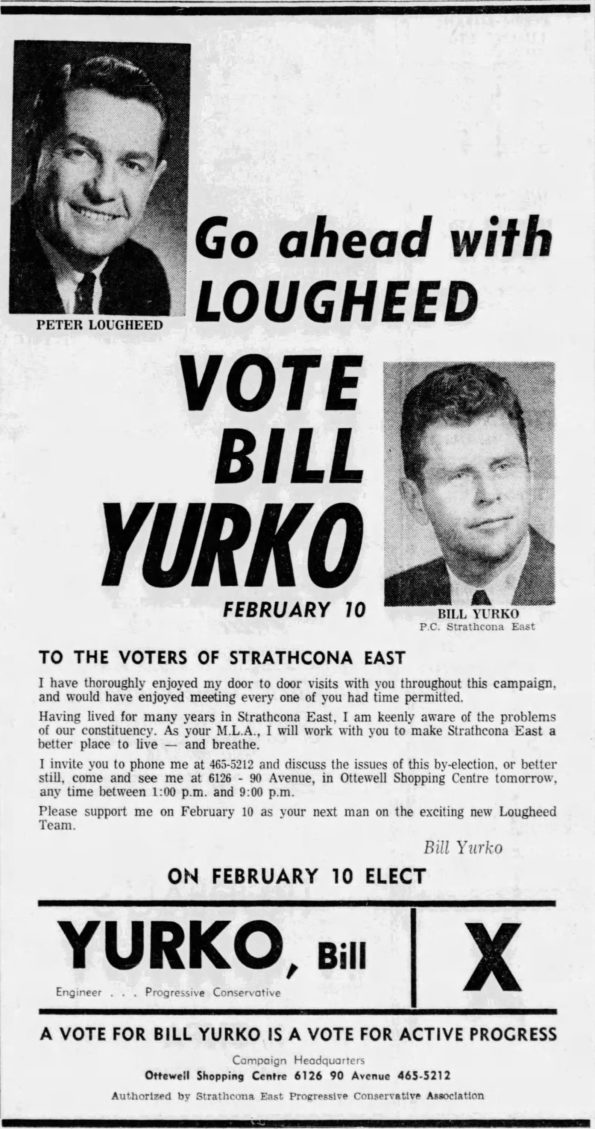 Young PC candidate Bill Yurko stole the Strathcona East seat vacated by retired Premier Ernest Manning in 1969, foreshadowing the demise of Social Credit only a few years later.
Young PC candidate Bill Yurko stole the Strathcona East seat vacated by retired Premier Ernest Manning in 1969, foreshadowing the demise of Social Credit only a few years later.
Even the New Democrats have squeaked in a surprise by-election win, though you’ll have to go way back to find it.
Pincher Creek-Crowsnest. 1966.
Garth Turcott becomes the first Alberta NDP MLA in the province’s history.
It was a seat with a proud history of radical coal miner unionism, socialism and communism but like most of Alberta it had been held in the tight grip of the Socreds for over three decades.
Turcott’s team brought in a professional organizer and used new campaigning techniques like “doorknocking.”
Federal NDP leader Tommy Douglas even lent Turcott’s campaign a hand and drew hundreds of people to a by-election rally in the riding.

Douglas roasted Premier Ernest Manning for standing in the way of public health care.
“He has been the spearpoint of the attack on medicare,” Douglas said of the Alberta Premier.
It’s probably how Rachel Notley would describe Jason Kenney today. She’d be right.
But that’s for another column.
Slide back to the present. March 14, 2022.
What a wild ride.
I’d love to take the time machine to tomorrow night to see how the Fort McMurray-Lac La Biche by-election turns out but our tank is almost empty (and radioactive plutonium almost costs as much as a tank of gas these days!).
So we’ll have to take a big deep breath and wait to see if Brian Jean reclaims his old seat tomorrow night.
It might be a Jean slam dunk, but as we just saw on our little journey through Alberta history – sometimes by-elections can have unexpected results.
- Tags Alberta Liberal Party, Alberta NDP, Alberta Party, Alberta Politics Time Machine, Alberta Social Credit Party, Ariana Mancini, Barry McFarland, Bill Yurko, Brian Jean, Calgary-Elbow, Calgary-Glenmore, Cardston-Taber-Warner, Craig Cheffins, Don MacDonald, Donna Graham, Ernest Manning, Fort McMurray-Lac La Biche, Fort McMurray-Lac La Biche by-election, Garth Turcott, Gordon Kesler, Greg Clark, Jason Kenney, Laurence Decore, Little Bow, Paul Hinman, Peter Lougheed, Pierre Trudeau, Pincher Creek-Crowsnest, Rachel Notley, Ralph Klein, Strathcona East, Three Hills, Tommy Douglas, United Conservative Party, United Conservative Party Leadership Review, Western Canada Concept, Wildrose Party
Supporters of the Alberta Liberal Party will gather virtually this weekend for the party’s annual general meeting two years after the party was shut out of the Legislative Assembly for the first time in more than three decades.

This year also marks 100 years since the Liberal Party lost the 1921 election to the United Farmers of Alberta after governing the province since it was founded in 1905.
The Liberals formed the official opposition for most of the period from their defeat until the 1967 election, when the Progressive Conservatives led by Peter Lougheed knocked the Liberals to third place in the Legislature.
As the Liberals ponder what it means to be a seatless party in 2021, I took a look back at what happened the last time the Liberals were shut out of the Legislature.
The 1967 election marked the Liberal Party’s poorest showing in decades, and death, defection and resignation would mean the party’s three MLA caucus would not survive the full term.
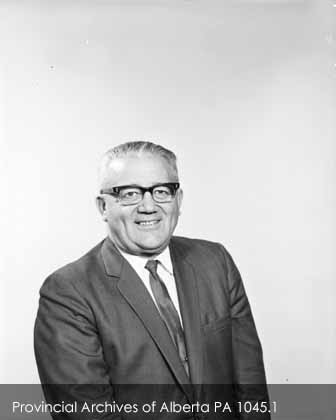
Party leader and Lac La Biche MLA Michael Maccagno resigned his seat in early 1968 to run in the federal election and later formally resigned as leader in October 1968. Edson MLA William Switzer died of a heart attack in June 1969. And in November 1969 the party’s sole remaining caucus member, Calgary-Glenmore MLA Bill Dickie, crossed the floor to join Lougheed’s PC Party.
The party was on the decline and faired poorly in the by-elections to replace Maccagno and Switzer, with Liberal candidates finishing third in Lac La Biche and fourth in Edson.
But that was not where this story of the Alberta Liberal Party’s ends.
Former United Church Minister Jack Lowery, who preached at Calgary’s Southwood United Church without collecting remuneration so he could work full-time as the public relations manager for ATCO Industries Ltd., was chosen as leader on April 26, 1969.
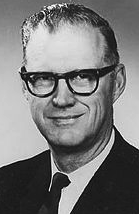
He was also the chief statistician for the Calgary Stampeder Football Club, where he led a team of analysts and technicians who tracked the CFL team’s performance. It is no wonder that Calgary Herald’s Johnny Hopkins described him in 1967 as someone who simply couldn’t find enough activities to fill all his waking hours.
With none of the party’s MLA entering the leadership race, Lowery defeated Town of Manning Mayor Don Branigan (who would later become Mayor of Whitehorse in Yukon), future party leader Bob Russell, and 20-year old University of Alberta political science student Trevor Midgley (who entered the race 8 minutes before the nomination deadline).
The 39-year old Lowery moved to Alberta after graduating from theology school in Toronto to serve churches in the Hardisty area and described himself as an “issues-oriented pragmatist” with a left-orientated slant on social development philosophy and “small conservative” financial ideas.
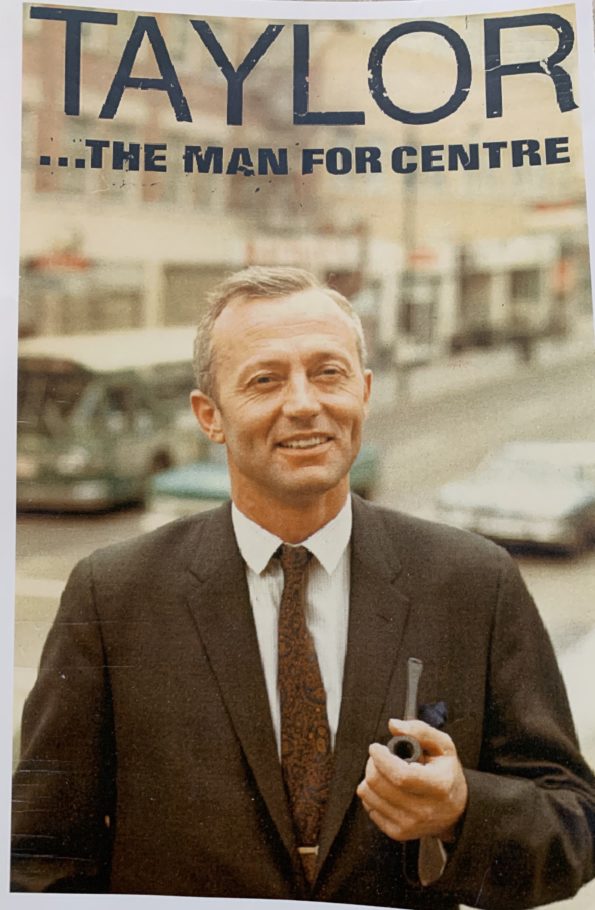
This was Lowery’s second foray into elected politics, having just the previous year mounted an unsuccessful campaign against oilman and school board trustee Nick Taylor for the federal Liberal nomination in Calgary-Centre (Taylor would go on to lead the Liberals back into the Legislature in 1986).
“It’s been said for a long time that there are those in the Liberal Party who have had a vested interest in defeat,” Lowery told Calgary Herald for the “Personality of the Week” column on May 30, 1969.
“They’ve been quite happy to go directly to Ottawa without having to work in a party structure that could go somewhere. All of these people will be encouraged to become party of the team,” Lowery said.

Lowery was an outsider who inherited the leadership of a deeply divided and cash poor party that was overshadowed by a flashier and increasingly unpopular federal Liberal Party led by Prime Minister Pierre Elliott Trudeau.
He was the Liberal Party’s third leader in five years following the resignation of Adrian Berry after nine months as leader in 1966 and the return of Maccagno as leader for a second time before Lowery was chosen.
Early on in his leadership he dismissed the chances of Lougheed’s PCs and pledged to reestablish the Liberals as the alternative to the long-governing Social Credit Party, which he described as “very long on promises and short on implementation.”
The decision by MLA Dickie to join the Lougheed PCs in November 1969 because of what he described as “leftist philosophy” in the Liberal Party meant the party no longer had any representation in Legislature.
“This merely clears the decks so that we can do the kind of building we’ve been wanting to do. I do not agree with him that we have a leftist philosophy,” said Lowery in response his Dickie’s defection.
But it all really started to unravel for Lowery when was revealed the next month that he had reached out to Social Credit Premier Harry Strom to either merge or create an electoral alliance between the two parties.
His fate was sealed.

“We can run candidates in the traditional sense in the next election. We can stand aside and let the Social Credit and Conservative partiee fight it out, or we can work with Social Credit to determine areas of mutual interest,” Lowery told the Calgary Herald on Dec. 30, 1969.
“We are 10 years away from being an effective political force and some form of coalition in which the Liberal party would retain its identity is one of the alternatives open,” Lowery said.
Calgary-South Liberal Member of Parliament Pat Mahoney, a former President of the Calgary Stampeders Football Club, said the idea should be pursued with an open mind.
“The Alberta Liberals have been unfairly burned by the identification with Ottawa and the necessity of supporting federal policies,” Mahoney told the Calgary Herald. “They have a right to pursue an independent course.”
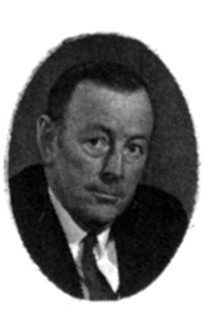
But Mahoney’s federal colleague from Edmonton had a different opinion. Edmonton-Strathcona Liberal MP Hu Harries called the proposal “bloody nonsense” and predicted it will not receive support from the Alberta Liberals membership.
Harries called on Lowery to resign and described talk of a Liberal-Socred alliance as a “selfish, stupid reaction to a complete failure” that was the Liberal Party’s inability to win the by-elections to replace the party’s former MLAs.
Prominent Edmonton Liberal and well-known publisher Mel Hurtig described the idea as absurd and clashed with Lowery at a party meeting in January 1970.
“Liberals are not people who are concerned with developing deals where they sell out their principles,” Hurtig was reported to have said.
Lowery defended his position by arguing that the merger discussions with the Socreds had “provoked interest and has given us an opportunity to delineate what we stand for as Liberals.”
But Harries and Hurtig were not alone. Constituency association presidents from across the province revolted against the idea – and Lowery.
And despite Lowery’s optimism, Strom’s own public response poured cold water on the entire idea of a Socred-Liberal alliance.
“We would be prepared to welcome those members of the Liberal party or any other party, who wish not join and work with us, but we are not at all interest in any deals or mergers,” Strom said.
The other opposition parties took it as an opportunity to welcome disaffected or confused Liberals into their camps.
Alberta New Democratic Party leader Grant Notley said his party would open wide the doors for disgruntled Liberals who wish to join “a genuine alternative to the conservative consensus of the Socreds and Tories.”
And Lougheed said any move toward a Liberal-Socred alliance would benefit his PC party.
“The last provincial election and the last two by-elections indicate that the majority of liberal-inclined voters would prefer to see a new progressive government in Alberta end 35 years of Social Credit control,” Lougheed said.
On February 16, 1970, only 10 short months after winning the leadership, Lowery resigned as leader of the Alberta Liberal Party.
He was replaced by the third-place finisher from the previous year’s leadership contest, Bob Russell.
A year later, Lowery re-emerged into the political spotlight to publicly announced he had left the provincial Liberals and was joining the Social Credit Party. He was soon after named the coordinator of the party’s Calgary campaign for the 1971 provincial election.
When the votes were counted on August 30, 1971, Lougheed’s PC Party had unseated the Socreds to form the first new government in Alberta since 1935. It was a political earthquake from which the Socreds would never recover.
And the Liberals remained shut out of the Legislature. The party’s vote dropped to 1.01 per cent and no where in Alberta did a Liberal candidate come close to winning election.
The Liberals would remain in the electoral wilderness in Alberta for the next 15 years.
(For more history about Liberal Party in Alberta during the 1960s and 1970s, check out Darryl Raymaker’s excellent book, Trudeau’s Tango. Alberta meets Pierre Elliott Trudeau).
- Tags Adrian Berry, Alberta Liberal Party, Alberta NDP, Alberta PC Party, Alberta Social Credit Party, ATCO, ATCO Industries Ltd., Bill Dickie, Bob Russell, Calgary Stampeders, Calgary-Centre, Calgary-Glenmore, Calgary-South, Darryl Raymaker, Don Branigan, Edmonton-Strathcona, Edson, Grant Notley, Harry Strom, Hu Harries, Jack Lowery, Johnny Hopkins, Lac La Biche, Michael Maccagno, Nick Taylor, Pat Mahoney, Peter Lougheed, Trevor Midgley, Trudeau’s Tango. Alberta Meets Pierre Elliott Trudeau, United Farmers of Alberta, William Switzer
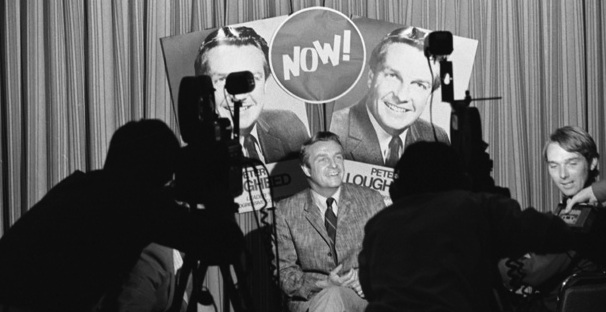
On August 30, 1971, the Progressive Conservative Party led by 43-year old Calgary lawyer Peter Lougheed were rocketed into government when they unseated the 36-year old Social Credit government led by 57-year old Harry Strom.
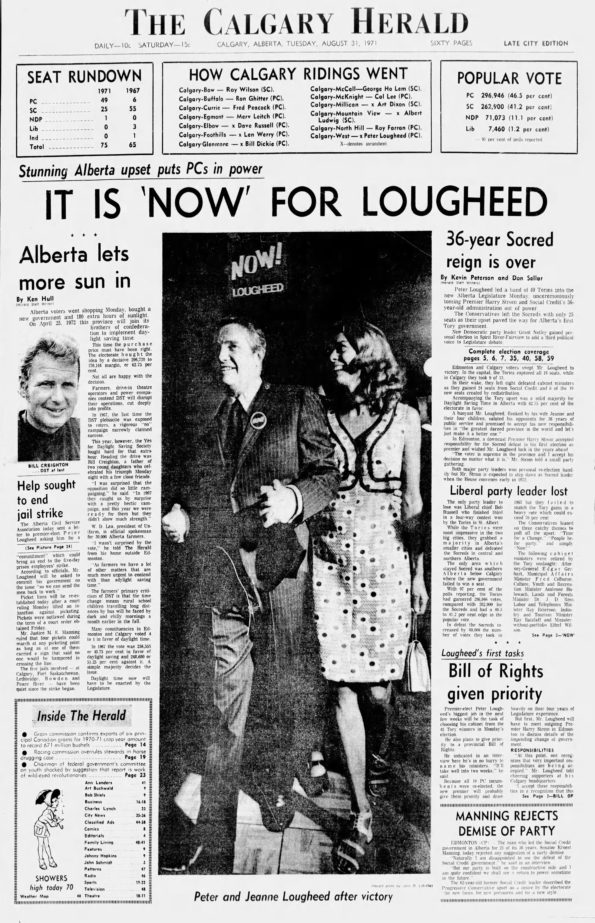
It was a shift that, until recently, had happened only once every generation in Alberta: a change in government.
Lougheed’s election represented a generational shift, with the voting age dropping from 21 to 18 years old for the first time, and an urban shift, with a handful of new urban districts added to the electoral map dislodging the disproportionate rural majority that had dominated Alberta’s elections until that point.
As Ernest Manning’s successor, Strom inherited an aging dynasty that had governed Alberta since 1935. While he appeared open to new ideas, modernizing the long-in-the-tooth Socred government was a tall order.
In contrast, Lougheed embodied new ideas of a younger Alberta – or at least that’s what the mythology of that election tells us. His campaign was made for TV and the telegenic Lougheed could be frequently seen “main streeting” and running from door to door while canvassing for his party’s candidates.
Social Credit tried to revitalize their look, with go-go girls and live bands at their election rallies, but once voters decided that change was needed it was impossible for Strom to turn that around. And the iconic NOW! slogan of Lougheed’s campaign tapped into that feeling.
The Lougheed PCs were not alone. They had the financial backing of corporate Calgary, including generous support from the Mannix Corporation, which employed Lougheed before he was first elected to the Legislature in 1967.
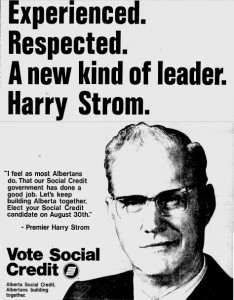
The PCs won with 49 seats and 46.4 per cent of the popular vote, sweeping out Social Credit, which, with 25 seats and 41.1 per cent of the vote formed the Official Opposition for the first time. While the Social Credit Party would wither in the opposition benches and eventually shrink into a 4 MLA rump that would survive until the early 1980s, Lougheed’s first victory transformed Alberta politics for the next five decades.
The PCs would form commanding majorities until their defeat to Rachel Notley’s New Democratic Party in 2015.
Also elected in 1971 was NDP leader Grant Notley, who would represent the northern rural district of Spirit River-Fairview until 1984. The NDP narrowly missed out electing a few other MLAs in this election, and Notley would remain the party’s only MLA – and the only social democratic voice in the Legislature – until Ray Martin was elected in Edmonton-Norwood in 1982.
The Alberta Liberal Party, which had formed Official Opposition before Lougheed’s PCs earned the spot in 1967, were wiped off the political map and would remain in the political wilderness until 1986.
In politics timing is everything, and Lougheed lucked out. Massive windfalls in oil and gas revenues led to overflowing government coffers, allowing the PC government to make major investments in public infrastructure like hospitals, schools, universities and colleges. The Lougheed PCs founded the The Banff Centre, the Kananaskis Country recreation area, and even bought an airline – Pacific Western Airlines.
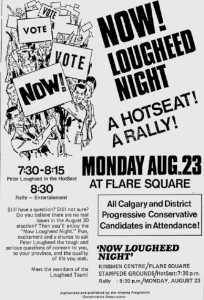
Lougheed’s government introduced a Bill of Rights, created the Legislature Hansard, and dissolved the notorious Alberta Eugenics Board.
The difference between Lougheed and some of his successors in Alberta’s Conservative dynasty was his belief that government had a positive role to play in society (a Reform Party Member of Parliament named Jason Kenney once criticized Lougheed’s legacy of “neo-Stalinist make-work projects.”)
Lougheed believed Alberta should behave like an owner of our oil and gas resources and that the government should collect its fair share of revenues. Royalty revenues were much higher than today, peaking at 40 per cent during his time as Premier. The oil companies complained but Lougheed was persistent.
“This is a sale of a depleting resource that’s owned by the people. Once a barrel of oil goes down the pipeline it’s gone forever. It’s like a farmer selling off his topsoil,” Lougheed once said.

Lougheed’s government also negotiated landmark financial investments from the federal government and the Ontario government in the oil sands that kickstarted development of the deposits when private investors would not take the risk. These government investments in Alberta’s oil industry likely helped save companies like Suncor when the international price of oil plummeted in the 1980s.
Relations between Lougheed’s government and Ottawa soured following the introduction of the National Energy Program, creating a political wedge that Conservative leaders have continued to crank ever since. But he always made sure he was seen as advocating for Alberta in a strong Canada and was a key player during the Constitution-making negotiations of the early 1980s.
The Heritage Savings Trust Fund is one of Lougheed’s biggest legacies. Today the trust fund is seen as a visionary move to save money for future generations of Albertans, which it is in a way, but it was also a result of a government that at one point literally had more money that it knew what to do with.
Lougheed commanded the loyalty of his cabinet, caucus and party – which built a political dynasty that would span four decades but also gave him a bit of an autocratic reputation.
PC MLAs would be required to share frequent local membership and fundraising updates with the Premier’s Office and Lougheed was known to make monthly calls with local PC Party association presidents in order to create a system of accountability with his local leaders. And there have also been stories that Lougheed kept undated and signed letters of resignation from his cabinet ministers in order to avoid having to fire anyone who became a political liability.
There is a Camelot-like mythology to Lougheed’s time in office. He towers over Alberta politics in ways that more recently popular leaders like Ralph Klein do not. While Klein was a populist, Lougheed was a builder. The oil money sure helped, but so did having a vision for making this province a better place.
Day Light Saving Time Referendum
Nothing is new under the prairie sun. In 1971, Albertans voted to adopt Daylight Saving Time in a province-wide referendum after voting against DST in a 1967 referendum. This October 2021, Albertans will vote whether to abandon the time change and permanently adopt Daylight Saving Time.
Newspaper Election Ads from 1971
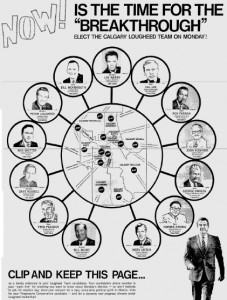
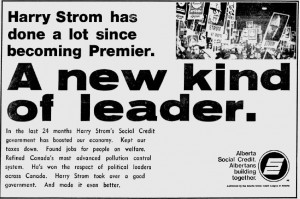
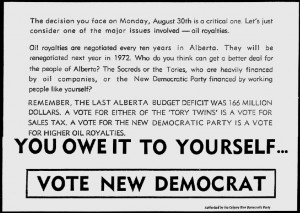
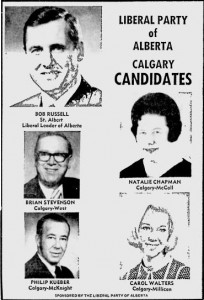
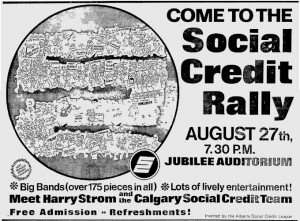
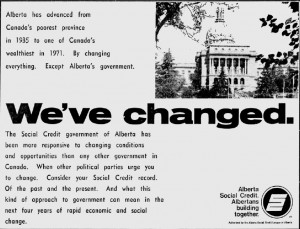
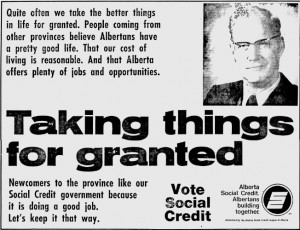
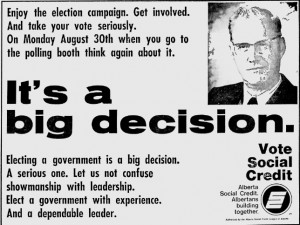
- Tags 1971 Alberta Election, Alberta Heritage Savings Trust Fund, Alberta Liberal Party, Alberta NDP, Alberta PC Party, Alberta Social Credit Party, Daylight Saving Time, Edmonton-Norwood, Ernest Manning, Grant Notley, Harry Strom, Jason Kenney, National Energy Program, Peter Lougheed, Rachel Notley, Ralph Klein, Ray Martin, Spirit River-Fairview

Podcast: Play in new window | Download
Subscribe: RSS
Kevin Van Tighem joins the Daveberta Podcast to discuss one of the biggest issues in Alberta politics today – the expansion of open-pit coal mining in the Eastern Slopes of the Rocky Mountains.
Kevin explains how the 1976 Coal Policy protected larges swaths of the Rocky Mountains from open-pit coal mining and the impact these large scale industrial projects would have on local wildlife habitat, local economies, and the water that millions of Albertans depend on.
We discuss the influence of mining companies over the Alberta government, the reasons why Energy Minister Sonya Savage rescinded the policy last spring, and what kind of improvements could be included in a new coal policy.
Kevin Van Tighem is a conservationist, former Superintendent of Banff National Park, and author whose books include Our Place: Changing the Nature of Alberta. You can read his columns in AlbertaViews Magazine.
The Daveberta Podcast is hosted by Dave Cournoyer and produced by Adam Rozenhart.
The Daveberta Podcast is a member of the Alberta Podcast Network: Locally grown. Community supported. The Alberta Podcast Network includes dozens of great made-in-Alberta podcasts.
You can listen and subscribe to the Daveberta Podcast on Apple Podcasts, Google Play, Spotify, Stitcher, or wherever you find podcasts online. We love feedback from our listeners, so let us know what you think of this episode and leave a review where you download.
Recommended Reading
- Who opposes Kenney’s decision to allow open-pit coal mining in Alberta’s Rockies? Basically everybody. (Daveberta.ca, Feb. 5, 2021)
- The Truth, the Coal Truth, and nothing but the Truth (Daveberta.ca, Feb. 2, 2021)
- Bringing Coal Back (CBC Interactive Feature, July 7, 2020)
- Alberta is planning new mountaintop-removal coal mines. Here’s what that looks like (The Narwhal, Dec. 20, 2020)
- Alberta’s ‘back door’ plan to free up billions of litres of water for coal mines raises alarm (The Narwhal, Feb. 1, 2021)
- Months Before Albertans Were Told, Australian Miners Knew Plans to Axe Coal Policy (TheTyee, Jan. 29, 2021)
- ‘It’s sickening’: Future generation worried about inheriting legacy of coal mining (Global News, Feb. 4, 2021)
- Changes to Alberta coal policy coming next week after province-wide outrage (Global News, Feb. 5, 2021)
- Alberta faces backlash after move to scrap coal policy, ease restrictions on mining (Globe & Mail, Jan. 24, 2021)
- ‘Morally and ethically wrong:’ Court to hear challenge to Alberta coal policy removal (CBC, Jan. 17, 2021)
- Alberta defends decision to allow for open-pit coal mining in Rocky Mountains (CBC, Jan. 19, 2021)
- Tags Adam Rozenhart, Alberta Coal, Alberta Coal Policy, Alberta Eastern Slopes, Alberta Election Podcast, Alberta Energy Regulator, Alberta NDP, Alberta Podcast, Alberta Podcast Network, Alberta Politics Podcast, Alberta Rocky Mountains, Dave Cournoyer, Daveberta Podcast, Jason Kenney, Jason Nixon, Kevin Van Tighem, Peter Lougheed, Rachel Notley, Rimbey-Rocky Mountain House-Sundre, Shannon Phillips, Sonya Savage, United Conservative Party
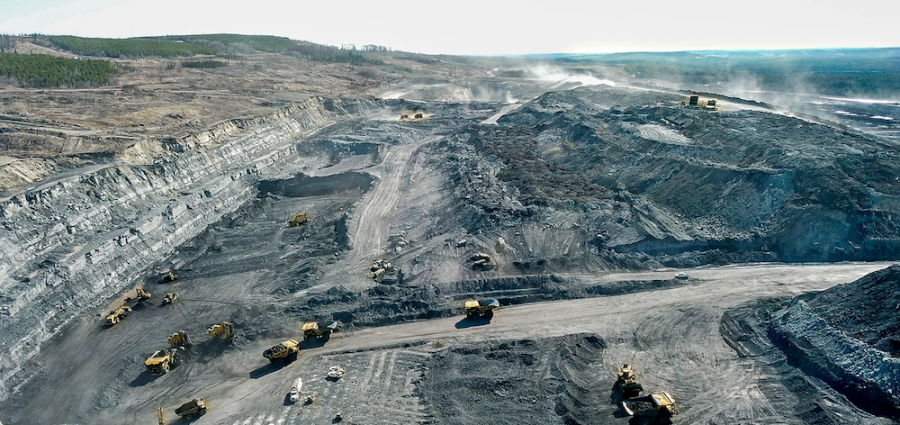
The United Conservative Party government’s decision to unilaterally rescind a 1976 Coal Policy that protected large swaths of Alberta’s Rocky Mountains and Foothills from open-pit coal mining has hit a nerve with Albertans.
Similar to the UCP government’s decision to close or privatize more than 160 provincial parks, which the government began to slowly back away from after widespread opposition in 2020, the decision to rescind the Coal Policy and enthusiastically support open-pit coal mining is an issue that is facing opposition across Alberta.
The opposition to the Coal Policy reminds me somewhat of the fight over electrical transmission lines that the old Progressive Conservative government stumbled into in the mid-2000s. In both cases, Conservative governments forgot how to listen to and speak with to their long-time rural supporters – and in the case of the PCs there were big consequences in the following election.
But in this case, the coal issue transcends the urban-rural divide that Alberta politicians sometimes like to exploit.
Albertans are proud of our Rocky Mountains. And we are acutely aware of how exploding the tops off those mountains would destroy habitat and pollute the water sources that millions of Albertans depend on.
Highwood UCP MLA RJ Sigurdson, who’s district includes part of the area directly impacted by the decision, says he is listening to his constituents concerns but he has not broken with his government on the issue. Livingstone-Macleod UCP MLA Roger Reid claimed the decision was made by the Alberta Energy Regulator, even though the policy was actually rescinded by Energy Minister Sonya Savage.
Describing the Peter Lougheed-era Coal Policy as outdated, Premier Jason Kenney dismissed the opposition by claiming critics of open-pit coal mining were mostly “city-dwellers.” But the chorus of opposition from Albertans who actually live on the Eastern Slopes of the Rockies tells the true story.
Who opposes the Kenney government’s decision to remove the 1976 Coal Policy?
The opposition to Kenney’s removal of the coal policy has been building since 2020, with ranchers, farmers and conservation, hunting, recreation and environmental groups, and the NDP opposition raising the alarm. But the opposition to Kenney’s coal push got a big boast when country music artists Corb Lund, Paul Brandt, Terri Clark, and kd lang, Heartland actor Amber Marshall, and television’s Terry Grant (aka the Mantracker) spoke out against the removal of the Coal Policy and in favour of protecting the Rockies and Foothills from open-pit coal mining.
Bearspaw, Ermineskin and Whitefish Lake First Nations – Landowners and the Ermineskin and Whitefish Lake First Nations have filed separate requests for a judicial review of the decision, which they argue was made without legally required consultations. (Alberta Native News, Jan. 18, 2021)
Municipal District of Ranchlands – Several groups are seeking intervenor status to join the ranchers seeking a judicial review: the M.D. of Ranchland, the Bearspaw, Siksika, Kainai and Whitefish First Nations, the Canadian Parks and Wilderness Society, the Alberta Hiking Association, the Alberta Backcountry Hunters and Anglers Association, the Alberta Wilderness Association and the Livingstone Landowners Group. (CBC, Jan. 20, 2021)
Town of Claresholm: Town Council voted to send a letter following up on a June 20, 2020 letter to the Minister of Environment and the Minister of Energy, and to cc MLA Roger Reid and Premier Jason Kenney raising concern over the rescindment of the 1976 Coal Policy. (Town of Claresholm, Jan. 25, 2021)
Foothills County – Foothills councillors are expressing their concern with a lack of policy around coal mining in southern Alberta. Council agreed to draft a letter to the provincial government regarding the controversial application for the Grassy Mountain Coal Project, an $800-million coal mining operation proposed in the Crowsnest Pass by Benga Mining Ltd., a subsidiary of Australian parent company Riversdale Resources. (Okotoks Today, Jan. 25, 2021)
Town of Edson – Edson officials penned a letter to the premier on Jan. 19 that asked the province to reopen closed, already-developed metallurgical mines instead of moving forward with new ones. (Global News, Jan. 27, 2021)
Village of Longview – “We are definitely not in favour of it,” said Kathie Wight, mayor of Longview, a community of 334 that looks out on the rangelands and mountains of the province’s southwest. “More public consultation needs to be taken into consideration.” (Global News, Jan. 27, 2021)
Town of Nanton – The Town of Nanton has sent a letter, signed by the mayor, to Alberta’s premier stating its concerns about open pit coal mining in southwest Alberta. In the Jan. 20 letter, the Town first thanks Premier Jason Kenney and Sonya Savage, Alberta’s energy minister, for the government’s Jan. 18 announcement cancelling 11 recently issued coal leases and the pause in issuing coal lease sales in former “Category 2” lands, which include large swaths of the Eastern Slopes and were previously protected. (Nanton News, Jan. 27, 2021)
Town of Okotoks – Okotoks Town Council passed a motion to draft a letter addressed to Premier Jason Kenney and other members of the provincial government regarding the recently rescinded 1976 Coal Policy. The letter would request an immediate rollback on the rescinding of the policy, a consultation process on the desired changes to the policy, and an impact report on how the project may affect local water. (Okotoks Online, Jan. 28, 2021)
Town of High River – “Coal exploration is causing irreparable damage to the landscapes and watersheds as well as adversely affecting the public’s access, use and enjoyment of Crown lands,” says the letter from town council in High River, about 55 kilometres south of Calgary. (CBC, Feb. 1, 2021)
Town of Canmore – Canmore Mayor John Borrowman will write a letter to Premier Jason Kenney urging him and the UCP government to reinstate the 1976 Coal Development Policy that was rescinded last year. (Rocky Mountain Today, Feb. 2, 2021)
Kainai-Blood Tribe – The Kainai-Blood Tribe will be launching a legal challenge against the Government of Alberta over its decision to unilaterally rescind the 1976 Coal Policy. (Lethbridge Herald, Feb. 2, 2021)
Town of Turner Valley – Turner Valley town council voted in favour of submitting a letter to the provincial government regarding coal exploration, joining several other Alberta towns in doing so. The letter includes several requests, including for the provincial government re-instate the 1976 Coal Policy, to institute a consultation process with relevant stakeholders, and for an analysis of environmental, hydrological, economic, and recreational impacts of the proposed changes. (Okotoks Online, Feb. 3, 2021)
Siksika First Nation– Siksika First Nation is launching a legal challenge against the province’s decision to rescind its coal policy, effectively allowing open-pit coal mining in the Rockies. (Calgary Herald, Feb. 4, 2021)
City of Airdrie – City council voted unanimously Feb. 1 to offer support to municipalities in southern Alberta that are advocating against the development of open-pit coal mining in the Rocky Mountains. At the Feb. 1 meeting, Airdrie resident Jessica Jacobs submitted a letter to council as public correspondence, urging the City to take a stance against the Grassy Mountain Coal Project – an $800-million coal mining operation that has been proposed in the Crowsnest Pass. (AirdrieToday.com, Feb. 5, 2021)
City of Lethbridge – Lethbridge could be joining a chorus of communities across southern Alberta to voice concerns about the UCP government’s decision to rescind a 45 year old policy on coal mining. Councillors will discuss an official business resolution next Tuesday (Feb. 9) which, if adopted would have the mayor write to Premier Jason Kenney and the Ministers of Environment and Energy requesting the policy be reinstated. (MyLethbridgeNow.com, Feb. 5, 2021)
It has been reported that the Town of Black Diamond and Clearwater County are also expected to discuss the issue in the coming weeks. Calgary City Council will discuss the issue at a Feb. 8 meeting.
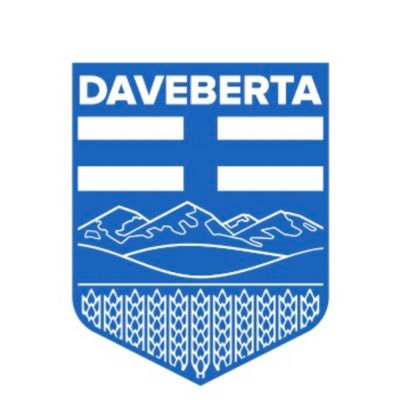 Listen and subscribe to the Daveberta Podcast to hear this weekend’s podcast discussion about the Coal Policy with writer and conservationist Kevin Van Tighem.
Listen and subscribe to the Daveberta Podcast to hear this weekend’s podcast discussion about the Coal Policy with writer and conservationist Kevin Van Tighem.
- Tags 1976 Coal Policy, Alberta Coal, Alberta Coal Policy, Alberta Dirty Coal, Amber Marshall, Bearspaw First Nation, City of Airdrie, City of Calgary, Clearwater County, Corb Lund, CPAWS, Ermineskin First Nation, Foothills County, Highwood, Jason Kenney, Kainai-Blood Tribe, KD Lang, Livingstone-Macleod, Municipal District of Ranchlands, Paul Brandt, Peter Lougheed, RJ Sigurdson, Roger Reid, Siksika First Nation, Sonya Savage, Terri Clark, Terry Grant, Town of Black Diamond, Town of Canmore, Town of Claresholm, Town of Edson, Town of High River, Town of Nanton, Town of Okotoks, Town of Turner Valley, United Conservative Party, Village of Longview, Whitefish Lake First Nation

Podcast: Play in new window | Download
Subscribe: RSS
In this episode of the Daveberta Podcast we discuss:
- the election of Joe Biden as President of the United States and the future of the Alberta government’s $7 billion investment into the Keystone XL Pipeline.
- the Kenney government’s response to the second wave of the COVID-19 pandemic and Health Minister Tyler Shandro’s plans to lay-off 11,000 health support workers.
- the Auditor General’s report and what it had to say about the Canadian Energy Centre.
We also take a deeper look at what Cypress-Medicine Hat UCP MLA Drew Barnes could be up to after he backed Edmonton-Ellerslie NDP MLA Rod Loyola’s motion to debate Canadian unity in the Alberta Legislature (Dave also nerds out about Alberta’s 1982 election, which took place 38 years to the day that Loyola introduced the motion).
And we dive into the mailbag to answer some great questions from our listeners.
The Daveberta Podcast is hosted by Dave Cournoyer and produced by Adam Rozenhart.
The Daveberta Podcast is a member of the Alberta Podcast Network: Locally grown. Community supported. The Alberta Podcast Network includes dozens of great made-in-Alberta podcasts.
You can listen and subscribe to the Daveberta Podcast on Apple Podcasts, Google Play, Spotify, Stitcher, or wherever you find podcasts online. We love feedback from our listeners, so let us know what you think of this episode and leave a review where you download.
Find us on Twitter, Instagram, Facebook, or you can email us at podcast@daveberta.ca. Thanks for listening.
Recommended Reading
- What Joe Biden’s win can tell us about Alberta politics — and where it might be going (CBC, Nov. 7, 2020)
- Alberta auditor flags $1.6B in government accounting blunders, oversight problems (Canadian Press, Nov. 5, 2020)
- Alberta’s energy war room under fire in auditor general’s annual report (CBC, Nov. 5, 2020)
- The truth about the UCP’s “fiscal responsibility” (The Sprawl, Nov. 7, 2020)
- With COVID-19 infections surging, Jason Kenney doubles down on failing voluntary strategy (AlbertaPolitics.ca, Nov. 7, 2020)
- After auditor general blast, it’s time to demobilize the war room (Postmedia, Nov. 7, 2020)
- Alberta town on verge of collapse due to aging oil wells (CTV, Nov. 8, 2020)
- Tags 1982 Alberta Election, 1982 Olds-Didsbury by-election, Adam Rozenhart, Alberta Election Podcast, Alberta Podcast, Alberta Podcast Network, Alberta Politics Podcast, Cypress-Medicine Hat, Dave Cournoyer, Daveberta Podcast, Donald Trump, Drew Barnes, Edmonton-Ellerslie, Gordon Kesler, Grant Notley, Jason Kenney, Joe Biden, Kamala Harris, Keystone XL Pipeline, Peter Lougheed, Rachel Notley, Ray Martin, Rod Loyola, Tyler Shandro, United Conservative Party, Western Canada Concept

The Battle of Alberta is a term usually reserved for competitions on the hockey rink or football field, but the rivalry between Calgary and Edmonton probably predates our professional sports clubs. While the animosity felt by some sports fans might not be felt the same way among voters, the politics and political divides between the two cities have helped defined Alberta politics since the province was created in 1905. From the decision of where to place Alberta’s capital city to where the province’s first university should be located, the roles played by the two major cities have been a periodic point of tension in provincial politics.
There are many reasons that explain the current political differences between the two cities, from the backgrounds of the settlers who founded the cities to the most recent round of economic convulsions.
As a friend of mine once put it, Calgary is where business decisions get made, Edmonton is where government decisions get made.
Calgary sees itself as the business capital, heavily influenced by connections to the American oil industry in Texas and the home of the braintrust of the federal Conservative movement. Edmonton is the government capital, heavily influenced by a combination of public servants and University employees as well as a base of blue-collar and trades workers with connections to Fort McMurray and northern Alberta.

These are obviously big generalizations that don’t reflect the diversity and complexity of the two cities but it does help explain some of the political differences between the two municipalities.
While I think the political differences between two two cities can sometimes be overstated, a troubling political narrative that has developed over the past six years has been that because Calgary is perceived to have felt the brunt of the economic fallout caused by the drop in the international price of oil, it is now Edmonton’s turn to feel the economic pain (translation: public sector wage rollbacks and job cuts).
There is an old saying in Alberta politics that a party has to win most of the seats in two of the three political regions of the province in order to form government – Calgary, Edmonton or rural Alberta. The “rural Alberta” in this calculation includes the small and medium size cities, which, with the exception of Lethbridge, have in the past four decades mostly voted in sync with the rest of rural Alberta – conservative.
But the calculation is generally correct. With a combined 46 seats in the Legislature, the two large cities represent the majority of Alberta voters (I hope to write more about voting patterns in “rural Alberta” in a future article).
This year marks one year since the United Conservative Party won the 2019 election and five years since the New Democratic Party won the 2015 election, undeniably two of the most important elections in Alberta’s recent political history. The two votes marked the first changes in government in Alberta since 1971, and both highlighted the political differences between Calgary and Edmonton.
The Progressive Conservatives had dominated Calgary since 1971 but in 2015 a combination of a surge of votes and the first-past-the-post electoral system allowed the NDP to elect 15 MLAs with 34 percent of the vote. The PCs earned 31 percent and the Wildrose placed third with 23 percent in Alberta’s largest city.

The 2015 election marked the first time since 1989 that the NDP had elected an MLA in Calgary and the first time since 1967 that a party other than the PCs won a majority of seats in the city.
While many prominent conservative pundits and politicians claimed the NDP breakthrough in Calgary, and much of the rest of Alberta, was a result of a vote-split on the political right, a closer look at that election would support the argument that the vote split was actually between the NDP and Wildrose among voters unhappy with the 43-year governing PC Party dynasty.
Edmonton has earned the nickname Redmonton for its reputation for electing more Liberals and NDP MLAs than anywhere else in the province. But despite the nickname, the capital city is historically more electorally competitive than it is an opposition bastion. Voters in the capital city have swung between parties more frequently than any other region in Alberta, making it one of the few consistently competitive areas of the province.
Led by Edmonton-Strathcona MLA Rachel Notley, the NDP swept the city in 2015, earning 65 percent of the total vote and winning every seat. The PCs earned 20 percent and the Wildrose finished with 8 percent in the capital city.
As one local PC Party campaign manager described to me after the 2015 election, their candidate faced “a giant impenetrable wall of orange.”
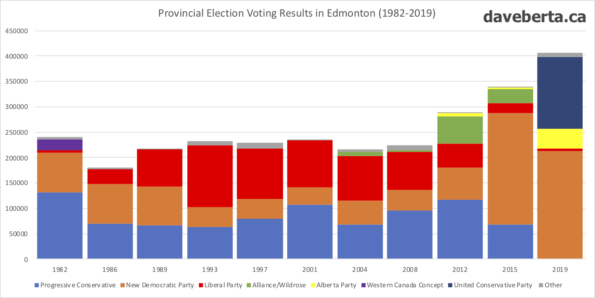
Four years later in 2019, the NDP maintained its vote share in Calgary but were only able to elect three MLAs as the UCP succeeded in consolidating the large base of PC and Wildrose voters, though a number of UCP candidates earned below the combined totals from the previous election. The NDP earned 34 percent of the vote and the UCP, led by Calgary-Lougheed MLA Jason Kenney, amassed 53 percent and elected 23 MLAs.
The seats won by Calgary NDP MLAs in the 2019 election have a tradition of electing non-conservative MLAs. Calgary-Buffalo and Calgary-Mountain View elected Liberals and NDP MLAs in the 1980s and 1990s, and Calgary-McCall swung to the Liberals in the 2000s.
Although the NDP lost all but one of the suburban surrounding the city, the party maintained its dominance in Edmonton in 2019, winning 53 percent of the vote and holding all but one seat. The UCP elected 1 MLA and earned 35 percent of the vote in the capital city.

The only viable third party in the 2019 election, the Alberta Party, earned 10 percent of the vote in both cities but failed to elect any MLAs. Party leader Stephen Mandel was unsuccessful in his bid for election in Edmonton-McClung and its two Calgary incumbents were defeated.
Past elections in the two cities
The results of these two elections, and how they have shaped Alberta politics in the most recent two election prompted me to take a broader look at voting results in Calgary and Edmonton over the past four decades.

1986: The departure of Peter Lougheed as Premier of Alberta in 1985 clearly had a big impact on Alberta politics, as the economic recession that followed allowed NDP led by Edmonton-Norwood MLA Ray Martin breakthrough in the capital city in the 1986 election.
Calgary remained a PC Party stronghold following Lougheed’s departure, with the NDP and Liberals electing a handful of MLAs between 1986 and 1997, and 2004 and 2012.
The election of Liberal Sheldon Chumir in Calgary-Buffalo in 1986 marked the beginning of a long-line of non-conservative MLAs representing that district. Non-conservative candidates would win in Calgary-Buffalo in nine of the next eleven elections (the district is currently represented by NDP MLA Joe Ceci).
Edmonton became the competitive hotbed of Alberta politics and a deep rivalry developed between Liberal Party and NDP partisans in the capital city.
The competition between the Liberals and NDP in Edmonton during this period generated much discussion around a “unite the left” movement to defeat the PCs, though this perennial debate largely became mute when the NDP formed government in 2015.
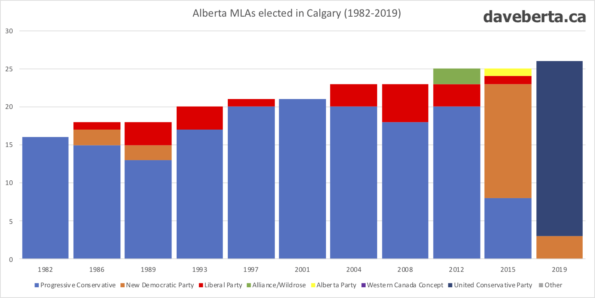
1993: In 1993, Premier Ralph Klein further consolidated his party’s electoral grip on Calgary while the Liberals led by former mayor Laurence Decore executed a clean sweep of the capital city. The Liberals were the beneficiaries of a collapsing NDP vote and also a burgeoning group of Reform Party voters wanting change on the provincial and federal levels.
The Liberals would again dominate Edmonton in the 1997 and 2004 elections, though the party began to resemble a group of independents more than the cohesive political organization created by Decore.
Competition between Decore’s Liberals and former Calgary mayor Klein’s PCs led to obvious descriptions of provincial politics as the battle of Alberta.
2001: The 2001 election marked a turn back toward the PC Party in Edmonton, which would then lose most of its seats when the Liberals and NDP rebounded in 2004 before regaining ground in the city in 2008 and 2012. This period marked the beginning of a decline of the Liberal Party in Edmonton after almost two decades as the official opposition party.
The 2001 election also marked the first time since 1982 that the PCs won every seat in Calgary.
2004: The 2004 election marked a breakthrough for the opposition Liberals in Calgary where the party elected three MLAs, the most since 1993. The Liberals would expand its voter base in Calgary and elect four MLAs in 2008 as the party’s fortunes in Edmonton sharply declined after it regained much of its seats in the 2004 election.
2012: The 2012 election marked a significant shift in the political environment in Alberta with the two large cities coalescing behind the PC Party. The opposition Wildrose Party swept much of rural Alberta, forming the first rural based official opposition party since the Social Credit Party in the 1970s. This trend would continue in the 2015 election as the Wildrose Party regained most of its seats following the 2014 floor-crossings.
(Note: Thank you to Shane Smith for sharing the poll level election maps. You can follow Shane on Twitter at @Smith80D).
- Tags 2008 Alberta election, 2012 Alberta election, 2015 Alberta Election, 2019 Alberta Election, Alberta Liberal Party, Alberta NDP, Alberta Social Credit Party, Battle of Alberta, Calgary-Buffalo, Calgary-Lougheed, Calgary-McCall, Calgary-Mountain View, Edmonton-McClung, Edmonton-Norwood, Edmonton-Strathcona, Jason Kenney, Joe Ceci, Laurence Decore, Peter Lougheed, Rachel Notley, Ralph Klein, Ray Martin, Redmonton, Sheldon Chumir, Stephen Mandel, United Conservative Party
Vintage campaign ads from the 1967 Alberta Election
- Post author By Dave Cournoyer
- Post date June 25, 2020
- 2 Comments on Vintage campaign ads from the 1967 Alberta Election
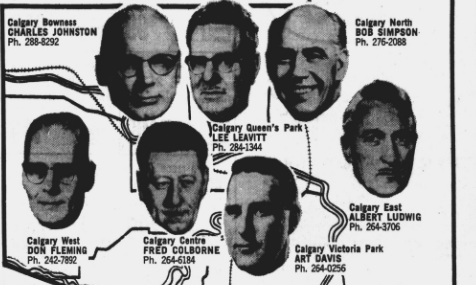
Going through some files last night I rediscovered some screenshots of newspaper advertisements from Alberta’s 1967 election. I posted them on Twitter and Instragam earlier today, but as fast as those social networks flow the images will be lost in the feed before long, so I thought I would share them here as well.
But first, a little bit of background on the significance of the May 23, 1967 general election in Alberta:
- It was the seventh and final election in which Premier Ernest Manning led the Social Credit Party, which had formed government since 1935. Social Credit MLAs were elected in 55 of 63 districts but this election marked the first time since 1955 that the party earned less than half of the popular vote. It would be the last time Albertans elected the Social Credit Party to form a government.
- It was the first election that Peter Lougheed led the Progressive Conservatives. The party formed official opposition with six MLAs, including future premier Don Getty and former PC Member of Parliament Hugh Horner, who acted as Lougheed’s rural lieutenant. The party had been shut out of the Legislature in the 1963 election.
- It was the last time until 1986 that the Liberal Party elected MLAs, three, to the Legislature. Party leader Michael Maccagno was re-elected in Lac La Biche, a district he had represented since 1955. Also standing as Liberal candidates were well-known Calgary Liberal Daryl Raymaker, who ran in Calgary-Queens Park, and J. Bernard Feehan, father of current Edmonton-Rutherford NDP MLA Richard Feehan, who ran in Edmonton-West
- The first New Democratic Party MLA elected to the Legislature in Alberta, Garth Turcott, was defeated. He became an MLA after winning a by-election in Pincher Creek-Crowsnest in 1966. Party leader Neil Reimer succeeded in increasing the party’s vote to 15 per cent, an increase of 6 per cent from the previous election, but the party failed to elect any MLAs.
- Future NDP leader Grant Notley was defeated in Edmonton-Norwood. Alderman Ivor Dent was unsuccessful as the NDP candidate in Edmonton-North East but would be elected mayor in the 1968 election.
- Defeated PC Party candidates in this election included future Prime Minister Joe Clark, who lost by 461 votes to Social Credit MLA Art Dixon in Calgary-South (Dixon would go on to defeat PC candidate and future Lieutenant Governor Norman Kwong in 1971).
- This election marked the last time an Independent candidate was elected in a general election. Independent Clarence Copithorne defeated Coalition MLA Frank Gainer in Banff-Cochrane.
- As far as my research could find, this was the first election that included an in-person leaders debate. Manning, Lougheed, Reimer and Maccagno gathered at a debate sponsored by the City Centre Church Council and held in downtown Edmonton. The leaders fielded questions from the audience in the packed church. This was the last time party leaders would meet for a debate until the 1993 election.
- This was the last provincial election where the voting age was 21 years old and the first which allowed voting by Indigenous people with Treaty Status.


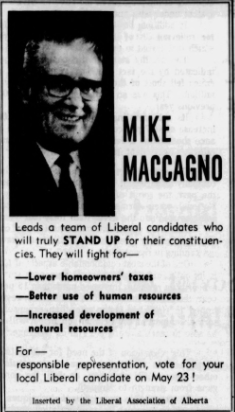

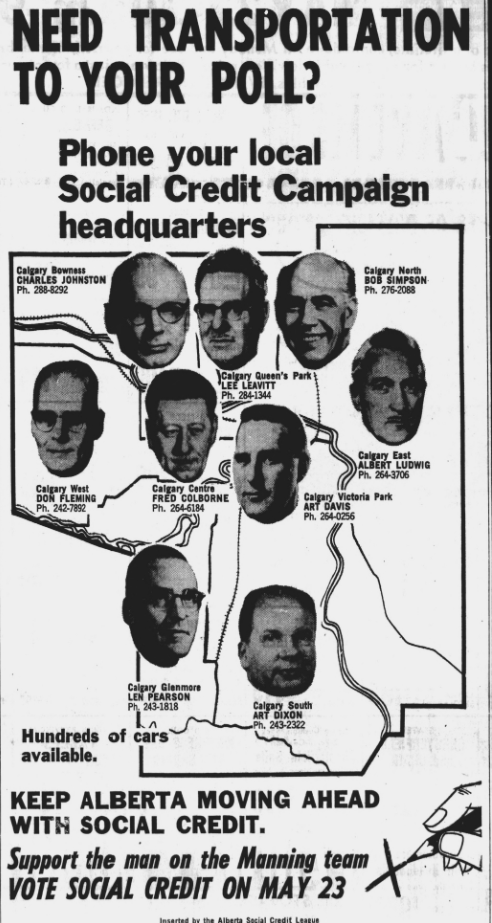
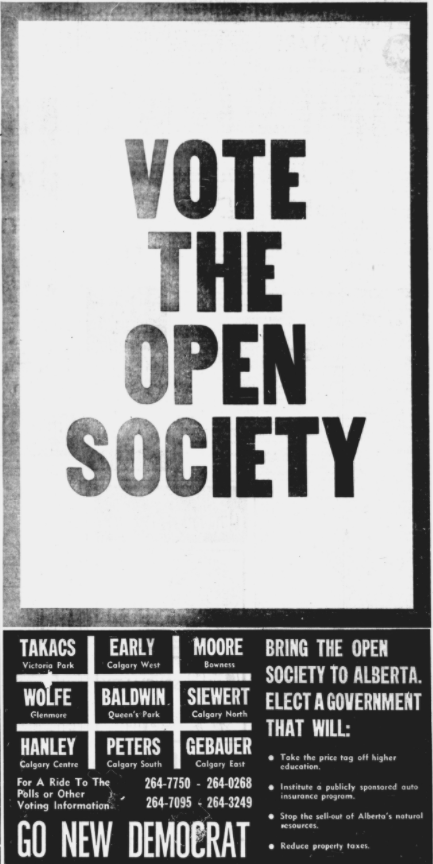


All of these ads were found in the Calgary Herald. If you liked these, check out some of the ads from Alberta’s 1971 general election.
- Tags 1967 Alberta Election, Alberta Liberal Party, Alberta NDP, Alberta PC Party, Alberta Social Credit Party, Art Dixon, Banff-Cochrane, Calgary-Queens Park, Calgary-South, Clarence Copithorne, Daryl Raymaker, Dave Russell, Don Getty, Edmonton-North East, Edmonton-Norwood, Edmonton-Rutherford, Edmonton-West, Ernest Manning, Frank Gainer, Garth Turcott, Grant Notley, Hugh Horner, Ivor Dent, J. Bernard Feehan, Joe Clark, Michael Maccagno, Neil Reimer, Norman Kwong, Peter Lougheed, Pincher Creek-Crowsnest, Richard Feehand
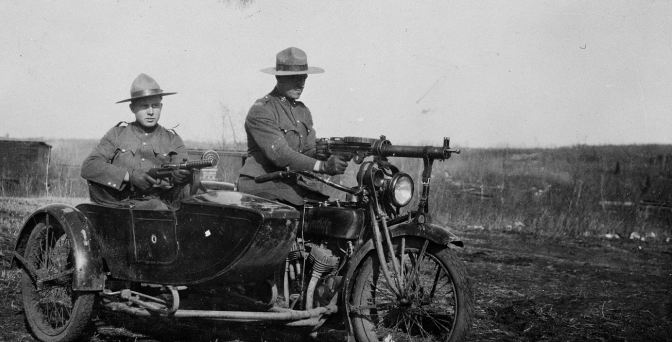
While much of my undergraduate studies at the University of Alberta focused on Canadian politics, one of my favourite courses covered a topic far away from the prairies – the Habsburg Monarchy. It was a combination of an unfamiliar topic and a passionate professor that made this course memorable. So my interest was piqued when the words “South Tyrol” began circulating in Alberta political circles this week.

“Should Alberta be an autonomous Province? South Tyrol has” asked Airdrie-East MLA Angela Pitt in a Facebook post linking to a website showcasing facts about the autonomous province in northern Italy.
While most of the separatist fever that swept Alberta following the re-election of Justin Trudeau’s Liberals in October 2019 appears to have subsided, the United Conservative Party government is expected to release the final report of the “Fair Deal Panel” when the province-wide state of emergency expires on June 15.
Unless she was planning a post-COVID vacation to the Dolomites, this is likely the reason why South Tyrol was on Pitt’s mind.
“Autonomous-province” sounds similar to the “sovereignty-association” historically promoted by some sovereigntists in Quebec but it is unclear whether in practice Alberta actually has more autonomy in Canada than does South Tyrol does in Italy. Canadian provinces already have incredible amounts of autonomy to do things like form parole boards, establish police forces (more on this in a moment), conduct adventures in foreign affairs and abdicate responsibility for approving oil sands development to unelected and unaccountable boards.
Much of South Tyrol’s status appears to be a result of it having a German-speaking majority population in a country where most people speak Italian. The former princely county of the Austro-Hungarian Empire was annexed by Italy after the First World War.
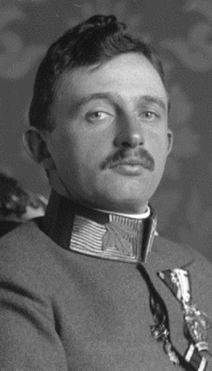
I expect many German-speaking South Tyroleans would probably prefer to re-join their linguistic cousins in Austria than remain in Italy.
I am not sure which other province or region Alberta would join if we adopt what might be Pitt’s version of an autonomous-province. Perhaps Frederick Haultain’s dream of a Province of Buffalo could be finally be realized if Alberta merged with its smaller cousin to the east, Saskatchewan? Or maybe British Columbia’s Peace Country will finally be released to unite with its northwestern Alberta cousins?
But Red Deer-South UCP MLA Jason Stephan is certainly whittling down the number of possible candidates.
Stephan apologized to the Legislative Assembly this week after describing other Canadian provinces as “hostile, parasitic partners” in a speech about federal fiscal policies and equalization program.
The rookie MLA and sole UCP backbencher appointed to the powerful Treasury Board committee also claimed that “Alberta must liberate itself from this mess.”
While Alberta is not going to separate from Canada, the final report from the government-appointed Fair Deal Panel will include recommendations to increase provincial autonomy from Ottawa.

The Fair Deal panel was announced by Premier Jason Kenney at last November’s gathering of Alberta conservatives at the Manning Centre conference in Red Deer.
The panel and its open-mic town hall meetings were both a relief valve and a steering wheel meant to allow Albertans to vent their frustrations while allowing Kenney to attempt to keep control of the latest burst of separatist fervour. The separatist fervour from Alberta’s right-wing fringe, despite the media attention it generated, now appears to have mostly died out.
The panelists included former Reform Party leader Preston Manning, former Progressive Conservative MLA Donna Kennedy-Glans, Peter Lougheed‘s son Stephen, and perennially disgruntled UCP backbencher MLA Drew Barnes of Cypress-Medicine Hat and fellow backbenchers Miranda Rosin of Banff-Kananaskis and Tany Yao of Fort McMurray-Wood Buffalo. The panel was tasked with making recommendations on topics including withdrawing from the Canada Pension Plan, replacing the Canada Revenue Agency by establishing a provincial revenue agency, opting out of federal programs like pharmacare, forming an office of a Chief Firearms Officer, and forming a provincial police force.

Kenney already announced plans to appoint a Chief Firearms Officer, one of the recommendations the panel was tasked with studying, and there has been speculation by Postmedia columnist Don Braid that the report could urge the creation of a provincial police force to replace the Royal Canadian Mounted Police in Alberta.
Once upon a time, Alberta, like most other provinces, had a provincial police force.
The Alberta Provincial Police was formed in 1917 after the North West Mounted Police hastily withdrew from policing in Alberta.
The NWMP had been created in 1873 and was part of the federal government’s suppression of the North West Rebellion in 1885, but, by 1917, Ottawa’s attention was focused on the First World War and there was little federal interest in enforcing provincial prohibition laws that had been enacted in 1916.
The APP merged into the RCMP in 1932 following negotiations between the provincial and federal governments during the Great Depression. The agreement to offload the costs associated with policing to the RCMP stipulated that former provincial police officers who transferred to the federal police would maintain their seniority and be eligible to receive pensions in accordance with their years of service.
When officers hung up their blue APP uniforms on April 15, 1932, it was reported in the Calgary Daily Herald that it took more than a month for the red RCMP uniforms to arrive in Alberta. So during the short period following the return of the federal police, RCMP officers worked in civilian clothes or, for those who worked as police in Alberta before 1917, wore the uniforms of the old NWMP.
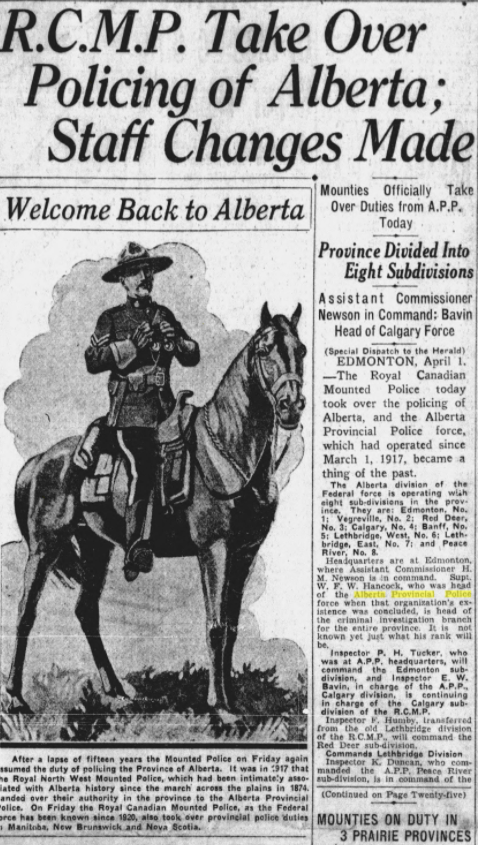
While Alberta politicians have generally expressed pleasure with contracting policing responsibilities to the federal government, there have been several attempts to reinstate a provincial police force.
A resolution at the United Farmers of Alberta convention of 1935 called for the re-instatement of the APP, but the UFA were swept away from Alberta politics when the party lost all its seats in that year’s election.
The next notable attempt to reinstate the APP came in 1937 from Edson MLA Joseph Unwin, the Whip of the Social Credit government caucus. Unwin introduced a motion to abolish the RCMP in Alberta and replace it with an Alberta Provincial Police Force.
Unwin argued that it was preferable that “the police force in the province should be indisputably at the exclusive orders of the attorney general.” Given this comment and the context of the time, it is fairly safe to speculate that Unwin was hoping to create a police force that would enforce the Social Credit ideological and political agenda in Alberta.
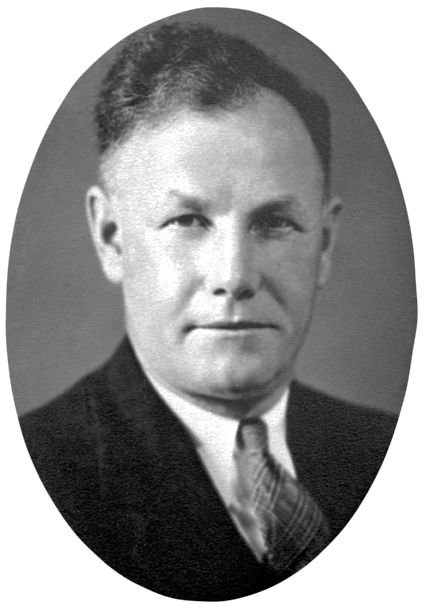
Unwin introduced the motion the same week he was arrested on charges of libel and counselling to murder in what would become known as the Bankers’ Toadies scandal.
Unwin and British Social Credit expert George Frederick Powell were arrested when police raided the party headquarters following the printing of a pamphlet advocating the “extermination” of nine prominent Edmontonians. The nine men, labelled as “Bankers’ Toadies,” included Conservative Party leader David Duggan and Senator and former mayor William Griesbach.
Unwin was sentenced to 3-months hard labour for the libel charge, which was later overturned on appeal. He did not resign as an MLA when he went to jail and his return to the Legislature was celebrated by Social Credit MLAs with a “snake dance” on the floor of the Assembly.
Unwin was defeated by Labour Party candidate and United Mine Workers president Angus Morrison in the 1940 election.
Various PC MLAs called for the creation of a provincial police force during the 1980s and early 1990s but most of those calls were quickly discredited because they were usually followed closely by racist comments about RCMP officers wearing turbans or speaking French.
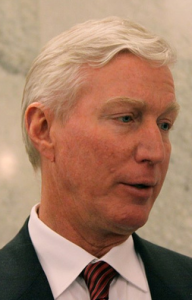
Anti-oil patch activist Wiebo Ludwig called for the creation of a provincial police force during his brief run for the Social Credit Party leadership in 2000 before having withdraw from the race after a judge refused to waive the conditions of his bail.
Motions recommending the creation of a regional police force or to make public studies conducted to assess the creation of a provincial police force were introduced by Wainwright MLA Doug Griffiths in 2003 and Lethbridge-East MLA Ken Nicol in 2004 were debated in the Legislature but gained no real traction.
But perhaps the most infamous call for the reinstatement of a provincial police force in Alberta came in the Firewall Manifesto in January 2001, signed by Conservative luminaries Stephen Harper, Tom Flanagan, Ted Morton, Rainer Knopff, Andrew Crooks and Ken Boessenkool.
In 2006, Morton, then a candidate for the leadership of the PC Party, called for the creation of a provincial police force, a proposal mocked by outgoing premier Ralph Klein. “We studied it and it was rejected,” Klein said. “Thus far, we’re getting a pretty good deal with the RCMP.”
Premier Ed Stelmach defeated Morton in the leadership race and signed a 20-year agreement with the federal Conservative government that would have the RCMP continue as Alberta’s police force until March 31, 2032.
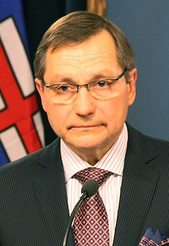
“This is wonderful news for the province and for Albertans,” Stelmach said in an August 2011 press release. “This agreement makes good financial sense for Alberta and strengthens a valuable relationship with a partner who continues to play a key role after more than a century keeping Alberta communities safe.”
In 2006, the Alberta Sheriffs Branch was created from the Courts and Prisoner Security branch.
The Fair Deal report will have to be publicly released before we know for sure what it recommends, but a move to create a new provincial police force in 2020 would face two powerful political factors
First, systematic racism and police violence against people of colour in the Canada and the United States has led to mounting calls to “defund the police.” Massive protests calling out systematic racism have taken place across the country, including a 15,000-strong rally outside the Legislature in Edmonton and similar rallies in Calgary and around the province. City councils and police commissions are now facing increased public pressure to reign in budgets and address systematic racism in the civilian police forces.
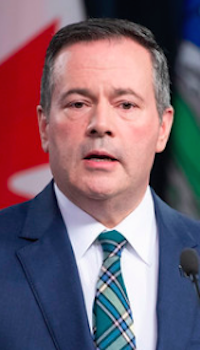
And most shockingly, video footage of RCMP officers assaulting Athabasca Chipewyan First Nation Chief Allan Adam has made international headlines.
Second, Kenney has said that a great reckoning is coming for Alberta’s finances, which will likely mean more massive job cuts in the public sector across Alberta. If the Kenney is laying-off teachers and nurses, it will be difficult for him to explain to Albertans that he needs to spend money on creating a brand new police force. A lack of finances was the main reason why the provincial police were disbanded in 1932.
For Kenney there is also the inconvenience of the RCMP’s investigation into whether a “kamikaze” campaign for the leadership of UCP in 2017 defrauded donors. That investigation is being guided by a special prosecutor from Ontario.
Creating a new provincial police force in this context would be incredibly tone deaf and completely unnecessary. But like many political decisions being made in Alberta lately, the world appears to be moving in one direction and our government moving in another. It kind of reminds me of those Habsburgs just over a century ago.
- Tags Airdrie-East, Alberta Firewall Manifesto, Alberta Provincial Police, Alberta Sheriffs Branch, Alberta Social Credit Party, Allan Adam, Andrew Crooks, Angela Pitt, Angus Morrison, autonomous-province, Banff-Kananaskis, Bankers' Toadies scandal, Charles I Habsburg, COVID-19 Pandemic, Cypress-Medicine Hat, David Duggan, Don Braid, Donna Kennedy-Glans, Doug Griffiths, Drew Barnes, Ed Stelmach, Fort McMurray-Wood Buffalo, George Frederick Powell, Habsburg Monarchy, Jason Kenney, Jason Stephan, Joseph Unwin, Justin Trudeau, Kamikaze campaign, Ken Boessenkool, Ken Nicol, Lethbridge-East, Miranda Rosin, North West Mounted Police, Peter Lougheed, Postmedia, Preston Manning, Province of Buffalo, Rainer Knopff, Ralph Klein, Red Deer-South, Royal Canadian Mounted Police, South Tyrol, Stephen Harper, Stephen Lougheed, Tany Yao, Ted Morton, Tom Flanagan, United Mine Workers, Wainwright, Wiebo Ludwig, William Griesbach
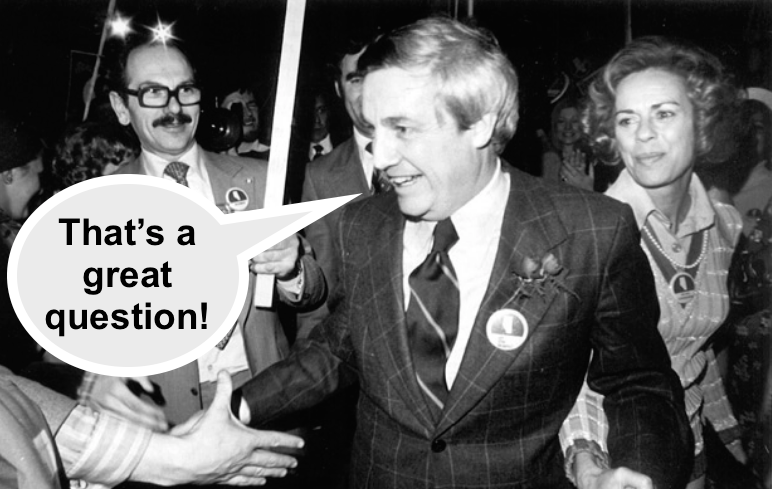
Podcast: Play in new window | Download
Subscribe: RSS
We dive into the mailbag in this episode of the Daveberta Podcast to answer questions about Alberta politics sent in by our listeners on topics ranging from the United Conservative Party’s influence on the Conservative Party of Canada leadership race to the details of the Alberta government’s Keystone XL Pipeline investment to Health Minister Tyler Shandro’s never-ending fight with Alberta’s doctors to how the 1918 Spanish influenza impacted Alberta politics and more great questions.
The Daveberta Podcast is a member of the Alberta Podcast Network, powered by ATB. The Alberta Podcast Network includes more than 30 great made-in-Alberta podcasts.
You can listen and subscribe to the Daveberta Podcast on Apple Podcasts, Google Play, Spotify, Stitcher, or wherever you find podcasts online. We love feedback from our listeners, so let us know what you think of this episode and leave a review where you download.
Find us on Twitter, Instagram, Facebook, or you can email us at podcast@daveberta.ca. Thanks for listening.
Recommended reading:
- Saudi Wealth Fund Builds Stakes in Canadian Oil Sands Giants (Bloomberg, May 15, 2020)
- Alberta ‘war room’ selling positive oilpatch pitches, but investors aren’t buying (Graham Thomson, May 15, 2020)
- Hinterland Who’s Who: Hear the haunting csll of the wild deep south Alberta UCP MLA… (AlbertaPolitics.ca, May 13, 2020)
- Trudeau says wealth fund blacklisting of Alberta companies a wake-up call on climate change action (CBC, May 12, 2020)
- Alberta doctors push back against government’s ‘divide-and-conquer’ strategy (CBC, May 8, 2020)
- Alberta’s Keystone XL investment benefits oil companies more than Albertans (Parkland Institute, April 2, 2020)
- Tags Adam Rozenhart, Alberta Election 2023, Alberta Medical Association, Alberta NDP, Alberta Party, Alberta Podcast, Alberta Politics Podcast, Andrew Scheer, Climate Change, Conservative Party of Canada Leadership Race 2020, COVID-19 Pandemic, Dave Cournoyer, Daveberta Podcast, Derek Sloan, Freedom Conservative Party, Greg Clark, Jacquie Fenske, Jason Kenney, Keystone XL Pipeline, Leslyn Lewis, Peter Lougheed, Peter Mackay, Rachel Notley, Sonya Savage, Stephen Mandel, Tyler Shandro, United Conservative Party, Wexit, Wexit Alberta
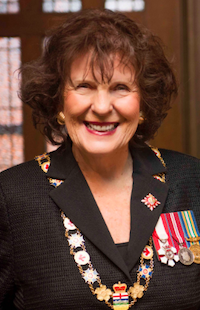
NDP leader Rachel Notley has asked Lieutenant Governor Lois Mitchell to not sign Bill 22: Reform of Agencies, Boards and Commissions and Government Enterprise Act when it passes third reading.
It is clear that the best interests of Albertans would be served by allowing the Office of the Election Commissioner to continue its investigations into violations of Alberta’s elections laws, an unlikely outcome if Bill 22 passes, but it is both a serious request and a risky and potentially ineffective political move to ask the Lieutenant Governor to intervene (as she is likely to decline, or worse, simply not respond to the request).
That said, the Lieutenant Governor does have a power known as reservation, which has rarely been exercised over Canadian history, and probably for good reason. The powers exist in Section 55 of the Constitution Act, and explained plainly, it means the Lieutenant Governor may adopt one of three courses of action in regard to any legislation passed by the Assembly: they may assent, they may “withhold” assent, or they may reserve their assent for “the Signification of the Queen’s Pleasure.”.
I am aware of two examples in recent history in which a Lieutenant Governor opted to withhold Royal Assent to a bill passed by a provincial legislature.
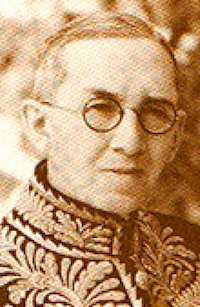
In 1937, Lieutenant Governor John Bowen refused to give Royal Assent to three bills passed by Premier William Aberhart’s Social Credit government, including the Accurate News and Information Act, which would have forced newspapers to hand over the names and addresses of their sources to the government, and to print government rebuttals to stories the provincial cabinet objected to. The unconstitutionality of the three bills was later confirmed by the Supreme Court of Canada.
In 1961, Saskatchewan Lieutenant Governor Frank Bastedo opted to withhold Royal Assent for a mineral rights bill, which was later approved through an order-in-council passed by the federal cabinet in Ottawa.
There have been two recent cases in Alberta’s history where Lieutenant Governor’s have publicly mused about withholding assent.
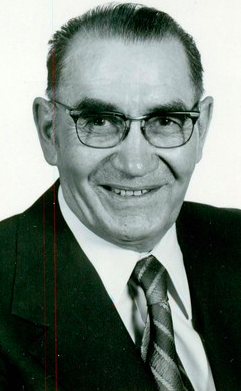
In 1977, Lieutenant Governor Ralph Steinhauer, the first person of Aboriginal heritage to be appointed to the post, considered withholding Royal Assent and publicly spoke against Bill 29:The Land Titles Amendment Act.
The bill introduced by Premier Peter Lougheed’s PC government was designed to prevent Aboriginal land claims in the northern Alberta, including the oilsands producing areas.
And in 2000, Lieutenant Governor Lois Hole publicly suggested she might have a long talk with Premier Ralph Klein before granting Royal Assent to Bill 11, a controversial health care bill.
And in one of the most odd-ball political plays including the Lieutenant Governor: the Kudatah. Opponents of Notley’s NDP government collected signatures for a petition to present to the Lieutenant Governor to hold a a plebiscite on the carbon tax and Farm safety laws or else they would enact a secret clause in the Elections Act to overturn the results of the May 2015 election (or something like that).
With everything else that is going on lately, I don’t think Albertans need or want a repeat of that.
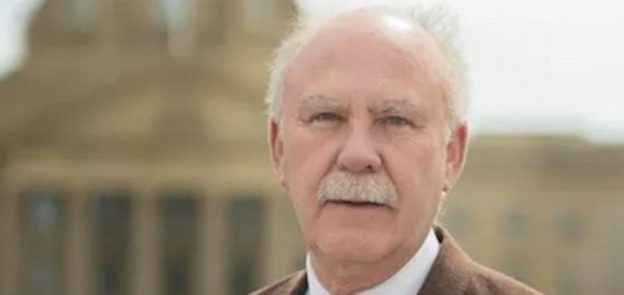
In an unusual but not unheard of piece of political theatre, New Democratic Party leader Rachel Notley was removed from the Legislative Assembly today when she refused to apologize for accusing the UCP government of obstruction of justice as it dissolves the independent Office of the Election Commissioner.

Notley knew what she was doing, and did not take it lightly, as she was willing to be thrown out of the Assembly for a day in order to make her point. This is the first time in recent memory that a leader of the official opposition has been removed from the Assembly.
Meanwhile, Premier Jason Kenney was on a plane to Texas safely avoiding controversy when his United Conservative Party government introduced the omnibus bill.
Bill 22: Reform of Agencies, Boards and Commissions and Government Enterprise Act, a 174-page omnibus bill, is packed with legislative changes, including major changes to Alberta’s public sector pension plans, cuts to historical and sports groups, and dissolves the Office of the Election Commissioner. That last move in effect fires Commissioner Lorne Gibson and likely shuts down his years-long investigation into the UCP’s 2017 leadership campaign that has already led to more than $200,000 in fines.
The Election Commissioner’s investigation is related to illegal or irregular donations to the so-called Kamakaze campaign of Jeff Callaway, the former Wildrose Party president whose brief run for the UCP leadership is considered to have been a stalking-horse for front-runner Kenney. The RCMP are conducting a separate on-going investigation into the UCP leadership campaign.

Kenney’s campaign closely collaborated with Callaway’s campaign, and Matt Wolf, now the Premier’s Executive Director of Issues Management, played an intimate role. But that’s not the shady backroom business that is being investigated by the Commissioner or the RCMP.
The Office of the Election Commissioner was created in 2017 because it was determined that the Chief Elections Officer did not have the resources or political independence to launch thorough investigations into violations of Alberta’s election finance laws.
Wildrose MLAs argued against the creation of his office and UCP supporters have both despised and dismissed Gibson’s investigations, but it is the timing and brazenness of the firing that was shocking.
Before it was tabled for First Reading in the Assembly, Government House Leader Jason Nixon moved to fast-track Bill 22 by severely limiting debate to one hour at each stage in the Legislative process.
Finance Minister Travis Toews has framed dissolving the Office of the Election Commissioner, with its $1 million annual budget, as a money saving decision. But at the same time, the UCP government is spending $2.5 million on a public inquiry to intimidate its political opponents and is providing a $30 million public relations subsidy to the oil and gas industry through the creation of Canadian Energy Centre Ltd.
The UCP are changing the rules because people involved in the party broke the rules and were starting to get caught. Kenney knew that firing the Election Commissioner would be unpopular, but he is clearly willing to spend significant political capital to end the investigations into the Kamikaze campaign. It is a cynical move that is bad for democracy and bad for Alberta.
Notley asks LG to not give Royal Assent to Bill 22

Notley has asked Lieutenant Governor Lois Mitchell to not sign Bill 22 when it passes third reading.
It is clear that the best interests of Albertans would be served by allowing the Office of the Election Commissioner to continue its investigations into violations of Alberta’s elections laws, an unlikely outcome if Bill 22 passes, but it is both a serious request and a risky and potentially ineffective political move to ask the Lieutenant Governor to intervene (as she is likely to decline, or worse, simply not respond to the request).
That said, the Lieutenant Governor does have a power known as reservation, which has rarely been exercised over Canadian history, and probably for good reason. The powers exist in Section 55 of the Constitution Act, and explained plainly, it means the Lieutenant Governor may adopt one of three courses of action in regard to any legislation passed by the Assembly: they may assent, they may “withhold” assent, or they may reserve their assent for “the Signification of the Queen’s Pleasure.”.
I am aware of two examples in recent history in which a Lieutenant Governor opted to withhold Royal Assent to a bill passed by a provincial legislature.

In 1937, Lieutenant Governor John Bowen refused to give Royal Assent to three bills passed by Premier William Aberhart’s Social Credit government, including the Accurate News and Information Act, which would have forced newspapers to hand over the names and addresses of their sources to the government, and to print government rebuttals to stories the provincial cabinet objected to. The unconstitutionality of the three bills was later confirmed by the Supreme Court of Canada.
In 1961, Saskatchewan Lieutenant Governor Frank Bastedo opted to withhold Royal Assent for a mineral rights bill, which was later approved through an order-in-council passed by the federal cabinet in Ottawa.
There have been two recent cases in Alberta’s history where Lieutenant Governor’s have publicly mused about withholding assent.

In 1977, Lieutenant Governor Ralph Steinhauer, the first person of Aboriginal heritage to be appointed to the post, considered withholding Royal Assent and publicly spoke against Bill 29:The Land Titles Amendment Act.
The bill introduced by Premier Peter Lougheed’s PC government was designed to prevent Aboriginal land claims in the northern Alberta, including the oilsands producing areas.
And in 2000, Lieutenant Governor Lois Hole publicly suggested she might have a long talk with Premier Ralph Klein before granting Royal Assent to Bill 11, a controversial health care bill.
And in one of the most odd-ball political plays including the Lieutenant Governor: the Kudatah. Opponents of Notley’s NDP government collected signatures for a petition to present to the Lieutenant Governor to hold a a plebiscite on the carbon tax and Farm safety laws or else they would enact a secret clause in the Elections Act to overturn the results of the May 2015 election (or something like that). With everything else that is going on lately, I don’t think Albertans need or want a repeat of that.
- Tags Accurate News and Information Act, Alberta NDP, Bill 22: Reform of Agencies, Bill 29:The Land Titles Amendment Act, Boards and Commissions and Government Enterprise Act, Frank Bastedo, Jason Kenney, Jason Nixon, Jeff Callaway, Kamikaze campaign, Kamikaze mission, Kudatah, Local Authorities Pension Plan, Lois Hole, Lorne Gibson, Matt Wolf, Office of the Elections Commissioner, Peter Lougheed, Rachel Notley, Ralph Klein, Ralph Steinhauer, Travis Toews, United Conservative Party, William Aberhart
